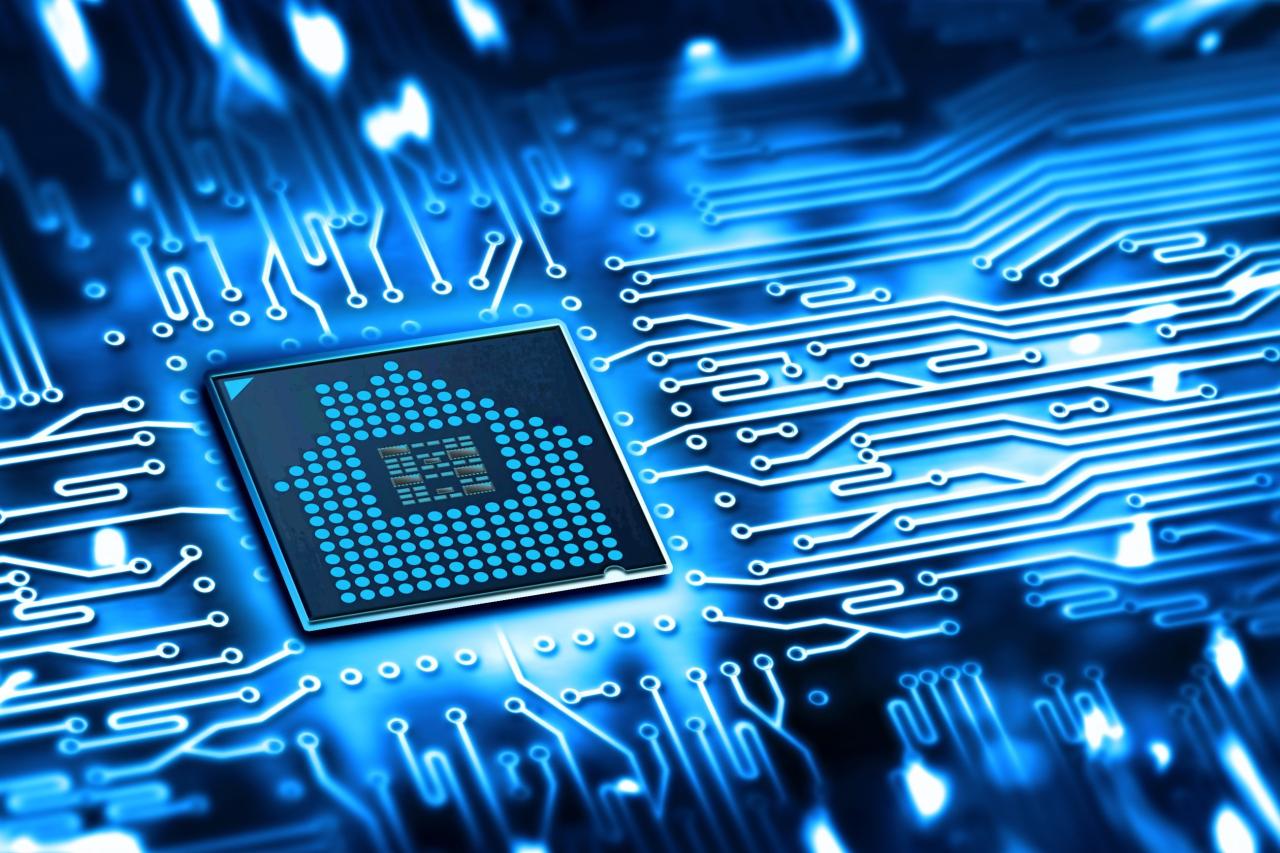Computer Electronics Technology: A Journey Through Innovation
Computer electronics technology has revolutionized our world, transforming the way we live, work, and interact. From the humble beginnings of the first computers to the powerful devices we use today, […]

Computer electronics technology has revolutionized our world, transforming the way we live, work, and interact. From the humble beginnings of the first computers to the powerful devices we use today, the evolution of computer electronics has been a remarkable journey marked by groundbreaking innovations.
This exploration delves into the core components that power our digital lives, exploring the intricate workings of the central processing unit (CPU), memory (RAM), storage devices, and input/output (I/O) devices. We’ll uncover the role of the motherboard in orchestrating these components and delve into the communication protocols that facilitate data transfer between them.
Evolution of Computer Electronics Technology
The evolution of computer electronics technology has been a remarkable journey, marked by groundbreaking innovations that have transformed the way we live, work, and interact with the world. From the early days of bulky, room-sized computers to the ubiquitous smartphones and powerful supercomputers of today, the advancement of computer electronics has been driven by relentless research and development.
Key Milestones and Innovations
The history of computer electronics is characterized by a series of significant milestones and innovations that have paved the way for the modern computing era.
- The ENIAC (Electronic Numerical Integrator And Computer): Developed in 1946, the ENIAC was the first general-purpose electronic computer. It was a massive machine, occupying a room the size of a small house, and used vacuum tubes for computation. The ENIAC played a crucial role in the development of ballistic tables for the US Army during World War II.
- The Transistor: Invented in 1947, the transistor revolutionized electronics by replacing bulky and power-hungry vacuum tubes with smaller, more efficient semiconductor devices. The invention of the transistor paved the way for the development of smaller, more powerful computers.
- The Integrated Circuit (IC): The concept of the integrated circuit was first proposed in 1958 by Jack Kilby, and it was later independently invented by Robert Noyce in 1959. The IC, also known as a microchip, integrates multiple transistors and other electronic components onto a single semiconductor chip. The invention of the IC enabled the miniaturization of electronic devices and led to the exponential growth of computing power.
- The Personal Computer (PC): The first personal computers, such as the Altair 8800, were introduced in the 1970s. The PC revolutionized computing by making it accessible to a wider audience.
- The Internet: The internet, a global network of interconnected computers, emerged in the 1980s. The internet has transformed communication, information sharing, and commerce, making it an indispensable part of modern life.
- Mobile Computing: The development of mobile devices, such as smartphones and tablets, has brought computing power to our fingertips. These devices are powered by powerful processors, high-resolution displays, and wireless connectivity, enabling us to access information, communicate, and perform various tasks on the go.
Impact of Semiconductor Technology
Advancements in semiconductor technology have played a pivotal role in the miniaturization and performance enhancement of computer electronics.
- Moore’s Law: In 1965, Gordon Moore, co-founder of Intel, predicted that the number of transistors that could be placed on an integrated circuit would double approximately every two years. This prediction, known as Moore’s Law, has held true for decades, driving the exponential growth of computing power and the miniaturization of electronic devices.
- Scaling of Transistors: Semiconductor technology has enabled the continuous scaling of transistors, making them smaller and more efficient. This miniaturization has allowed for the development of more powerful and compact computers, as well as the integration of multiple functionalities onto single chips.
- New Materials and Processes: The development of new materials and manufacturing processes, such as advanced lithography techniques, has further enabled the miniaturization and performance enhancement of semiconductor devices.
Von Neumann and Harvard Architectures
Computer architectures are fundamental designs that define the organization and operation of a computer system. Two prominent architectures are the Von Neumann architecture and the Harvard architecture.
- Von Neumann Architecture: The Von Neumann architecture uses a single address space for both instructions and data. This means that the CPU can access both instructions and data from the same memory location. The Von Neumann architecture is widely used in modern computers.
- Harvard Architecture: The Harvard architecture uses separate address spaces for instructions and data. This allows the CPU to access instructions and data simultaneously, potentially improving performance. The Harvard architecture is commonly used in embedded systems and digital signal processors.
| Feature | Von Neumann Architecture | Harvard Architecture |
|---|---|---|
| Address Space | Single address space for instructions and data | Separate address spaces for instructions and data |
| Data and Instruction Access | CPU can access both instructions and data from the same memory location | CPU can access instructions and data simultaneously |
| Performance | Generally slower due to shared memory access | Potentially faster due to separate memory access |
| Applications | Widely used in modern computers | Commonly used in embedded systems and digital signal processors |
“The Von Neumann architecture is a fundamental concept in computer design, and its impact on the development of computing is immeasurable.”
Core Components of Computer Electronics

A computer system is comprised of numerous interconnected components, each playing a crucial role in processing information and facilitating user interactions. Understanding the function and operation of these core components is essential for comprehending the overall workings of a computer.
Central Processing Unit (CPU)
The CPU, often referred to as the “brain” of the computer, is responsible for executing instructions and performing calculations. It acts as the central control unit, orchestrating the flow of data and instructions throughout the system.
- Arithmetic Logic Unit (ALU): Performs mathematical operations and logical comparisons on data.
- Control Unit: Directs the flow of data and instructions within the CPU, coordinating the activities of other components.
- Registers: Small, high-speed memory locations within the CPU used to temporarily store data and instructions during processing.
Memory (RAM)
RAM, or Random Access Memory, serves as a temporary storage space for data and instructions that the CPU actively uses. It is a volatile memory, meaning that its contents are lost when the computer is powered off.
- Data Storage: RAM holds data that the CPU is currently processing, allowing for quick access and manipulation.
- Program Instructions: Instructions from programs being executed are loaded into RAM for the CPU to access and execute.
- Speed: RAM is significantly faster than other storage devices, enabling the CPU to access data quickly.
Storage Devices
Storage devices provide long-term storage for data and programs, even when the computer is powered off. They differ in their storage capacity, access speed, and cost.
- Hard Disk Drive (HDD): A mechanical storage device that uses magnetic platters to store data. HDDs are relatively inexpensive but slower than SSDs.
- Solid State Drive (SSD): A faster and more durable storage device that uses flash memory to store data. SSDs are generally more expensive than HDDs.
- Optical Drives: Devices like CD-ROM, DVD-ROM, and Blu-ray drives use lasers to read data from optical discs.
Input/Output (I/O) Devices
I/O devices facilitate communication between the computer and the outside world. They allow users to input data and receive output from the system.
- Input Devices: Devices like keyboards, mice, touchscreens, and scanners allow users to input data and commands into the computer.
- Output Devices: Devices like monitors, printers, speakers, and projectors display or output data from the computer.
Motherboard
The motherboard acts as the central hub of a computer system, connecting and coordinating all the different components. It provides a platform for the CPU, RAM, storage devices, and other components to interact with each other.
- Component Interconnection: The motherboard provides slots and connectors for installing and connecting various components, such as the CPU, RAM, storage devices, and expansion cards.
- Data Communication: It facilitates communication between different components through bus systems, which act as pathways for data transfer.
- Power Distribution: The motherboard distributes power to different components through various connectors and circuits.
Communication Protocols, Computer electronics technology
Communication protocols define the rules and standards for data transfer between different components within a computer system.
- PCIe (Peripheral Component Interconnect Express): A high-speed communication protocol used for connecting expansion cards, such as graphics cards, network cards, and sound cards, to the motherboard.
- SATA (Serial Advanced Technology Attachment): A standard interface for connecting storage devices, such as hard drives and SSDs, to the motherboard.
Trends in Computer Electronics Technology
The field of computer electronics is constantly evolving, driven by innovation and the relentless pursuit of enhanced performance, efficiency, and capabilities. This evolution has given rise to a number of exciting trends that are shaping the future of computing. These trends are not merely technological advancements; they are fundamentally changing how we interact with technology and how we solve complex problems.
Artificial Intelligence (AI)
AI is transforming the way we interact with computers and the world around us. It is empowering machines to learn, reason, and make decisions in ways that were previously unimaginable. AI is being integrated into a wide range of applications, from self-driving cars to medical diagnostics, and its impact on computer electronics is profound.
- Hardware Acceleration: AI algorithms demand immense computational power. To meet these demands, specialized hardware like GPUs and AI accelerators are being developed to optimize AI workloads. These specialized processors are designed to handle the complex mathematical operations required for machine learning and deep learning tasks, significantly enhancing AI performance.
- Edge Computing: AI is increasingly being deployed at the edge of networks, closer to data sources. This enables real-time analysis and decision-making, reducing latency and improving responsiveness. Edge computing is critical for applications like autonomous vehicles, industrial automation, and smart cities, where low latency is paramount.
- AI-Driven Optimization: AI is being used to optimize the design and operation of computer systems. This includes optimizing hardware resource allocation, power consumption, and performance, leading to more efficient and responsive systems.
Quantum Computing
Quantum computing is a paradigm shift in computing, leveraging the principles of quantum mechanics to solve problems that are intractable for classical computers. This technology holds the potential to revolutionize fields like drug discovery, materials science, and financial modeling.
- Superposition and Entanglement: Quantum computers utilize superposition and entanglement, two fundamental quantum phenomena, to perform computations in ways that are impossible for classical computers. These properties allow quantum computers to explore multiple possibilities simultaneously, offering exponential speedups for certain types of problems.
- Quantum Algorithms: Quantum algorithms are specifically designed to take advantage of the unique properties of quantum computers. These algorithms can solve problems that are intractable for classical computers, such as factoring large numbers or simulating complex molecules.
- Impact on Computer Electronics: Quantum computing is still in its early stages, but its potential impact on computer electronics is immense. It could lead to the development of new types of hardware and software, and it could revolutionize the way we design and use computers.
Edge Computing
Edge computing is a distributed computing paradigm that brings computation and data storage closer to the source of data, eliminating the need to send data to centralized data centers. This approach offers several advantages, including reduced latency, improved bandwidth, and enhanced security.
- IoT and Connected Devices: Edge computing is a crucial enabler for the Internet of Things (IoT), as it allows devices to process data locally, reducing the strain on centralized networks. It is also essential for connected devices in various industries, such as healthcare, manufacturing, and transportation.
- Real-Time Data Analysis: Edge computing enables real-time data analysis, allowing for faster decision-making and improved responsiveness. This is particularly important for applications that require immediate action, such as autonomous vehicles and industrial automation.
- Data Privacy and Security: Edge computing can enhance data privacy and security by keeping sensitive data closer to the source, reducing the risk of data breaches and unauthorized access. This is crucial for applications that handle sensitive information, such as healthcare and finance.
Applications of Computer Electronics
Computer electronics have permeated every facet of modern life, revolutionizing industries and transforming the way we live, work, and interact with the world. From healthcare to finance, education to entertainment, the impact of computer electronics is undeniable, driving innovation and efficiency across various sectors.
Healthcare
Computer electronics have become indispensable in the healthcare industry, enabling advancements in diagnosis, treatment, and patient care. The integration of computer systems and medical devices has transformed the way healthcare professionals operate, providing real-time data analysis, automated tasks, and enhanced communication.
- Electronic Health Records (EHRs): EHRs have digitized patient medical records, simplifying data management, improving accessibility, and reducing errors. EHRs allow healthcare providers to access comprehensive patient information, including medical history, allergies, medications, and test results, facilitating informed decision-making and enhancing patient care.
- Medical Imaging: Computer electronics have revolutionized medical imaging, enabling non-invasive diagnostic techniques. Technologies such as Magnetic Resonance Imaging (MRI), Computed Tomography (CT) scans, and X-rays provide detailed images of internal organs and tissues, aiding in the detection and diagnosis of diseases.
- Telemedicine: Telemedicine utilizes computer electronics to provide remote healthcare services, bridging geographical distances and expanding access to specialized medical care. Telemedicine platforms enable virtual consultations, remote monitoring, and remote surgery, facilitating timely and efficient healthcare delivery.
Finance
Computer electronics have revolutionized the financial industry, streamlining processes, enhancing security, and enabling innovative financial products and services. The integration of computer systems has transformed the way financial institutions operate, facilitating automated transactions, real-time data analysis, and advanced risk management.
- Online Banking: Online banking platforms have made financial transactions more accessible and convenient, allowing customers to manage their accounts, transfer funds, pay bills, and access financial information from anywhere with an internet connection.
- Automated Trading: Algorithmic trading utilizes computer algorithms to execute trades automatically based on pre-defined parameters, reducing human error and maximizing efficiency. These algorithms analyze market data, identify trading opportunities, and execute trades at high speeds, enabling faster and more profitable trading strategies.
- Financial Modeling: Computer electronics have facilitated the development of sophisticated financial models, enabling financial institutions to analyze complex financial scenarios, assess risk, and make informed investment decisions.
Education
Computer electronics have transformed the education landscape, providing students with access to vast resources, personalized learning experiences, and interactive learning environments. The integration of computer systems has enhanced teaching methodologies, facilitated online learning, and created opportunities for global collaboration.
- E-learning Platforms: E-learning platforms provide students with access to online courses, tutorials, and interactive learning materials, enabling flexible learning schedules and personalized learning experiences.
- Virtual Reality (VR) and Augmented Reality (AR): VR and AR technologies create immersive learning experiences, bringing educational content to life and enhancing student engagement. VR simulations allow students to explore historical events, scientific concepts, or medical procedures in a virtual environment, while AR overlays digital information onto the real world, enhancing learning through interactive experiences.
- Educational Software: Educational software programs provide interactive learning tools, simulations, and assessments, supporting student learning in various subjects. These programs offer personalized learning paths, adaptive assessments, and real-time feedback, tailoring the learning experience to individual needs.
Entertainment
Computer electronics have revolutionized the entertainment industry, creating immersive experiences, personalized content, and new forms of entertainment. The integration of computer systems has transformed the way we consume and interact with entertainment, providing access to vast libraries of content, interactive gaming experiences, and personalized recommendations.
- Streaming Services: Streaming services such as Netflix, Spotify, and YouTube provide users with access to vast libraries of movies, music, and videos, allowing them to stream content on demand and personalize their viewing experience.
- Video Games: Video games have become a multi-billion dollar industry, utilizing computer electronics to create immersive and interactive experiences. Video games offer realistic graphics, complex storylines, and multiplayer gameplay, providing entertainment and escapism for millions of players worldwide.
- Virtual Reality (VR) and Augmented Reality (AR): VR and AR technologies are transforming the entertainment industry, creating immersive experiences and blurring the lines between reality and virtual worlds. VR games transport players into virtual environments, while AR overlays digital content onto the real world, enhancing entertainment experiences through interactive elements.
The Future of Computer Electronics
The relentless march of technology continues to reshape the landscape of computer electronics, promising a future brimming with groundbreaking innovations. From the realm of miniaturization to the burgeoning field of artificial intelligence, the future holds immense potential for advancements that will redefine our interactions with technology and impact society in profound ways.
Miniaturization and Power Efficiency
The relentless pursuit of miniaturization in computer electronics is driven by the desire to create devices that are smaller, more powerful, and consume less energy. This quest for miniaturization has already yielded remarkable results, with transistors shrinking to the nanoscale and processors becoming increasingly powerful while consuming less energy.
The future of miniaturization holds the promise of even smaller and more efficient devices. Quantum computing, for example, leverages the principles of quantum mechanics to perform calculations that are beyond the capabilities of traditional computers. This emerging technology has the potential to revolutionize fields such as drug discovery, materials science, and artificial intelligence.
“The future of computing is quantum computing.” – Michio Kaku, theoretical physicist
- Moore’s Law, which predicts that the number of transistors on a microchip doubles approximately every two years, is expected to continue for the foreseeable future, albeit at a slower pace. This means that we can expect to see continued miniaturization of computer components, leading to smaller, faster, and more energy-efficient devices.
- Nanotechnology is playing an increasingly important role in the miniaturization of computer electronics. Nanomaterials, with their unique properties, can be used to create smaller, more efficient, and more durable components. For example, nanowires can be used to create transistors that are significantly smaller and faster than traditional transistors.
- Three-dimensional (3D) integrated circuits offer a promising avenue for miniaturization. By stacking multiple layers of transistors vertically, 3D ICs can achieve higher density and performance while reducing the overall footprint of the device. This technology has the potential to significantly increase the computing power of devices while reducing their size and energy consumption.
Artificial Intelligence and Machine Learning
Artificial intelligence (AI) and machine learning (ML) are rapidly transforming the world around us, and their impact on computer electronics is profound. AI algorithms are becoming increasingly sophisticated, enabling computers to perform tasks that were once thought to be the exclusive domain of humans, such as image recognition, natural language processing, and decision-making.
The future of AI and ML in computer electronics holds the promise of even more intelligent and capable devices. For example, AI-powered assistants will become more sophisticated, capable of understanding complex commands and providing personalized recommendations. AI will also play a key role in the development of self-driving cars, smart homes, and other intelligent systems.
- Edge computing is an emerging trend that brings computing power closer to the source of data. This approach can reduce latency and improve the responsiveness of AI-powered applications, making them more suitable for real-time applications such as autonomous vehicles and industrial automation.
- Deep learning is a subfield of machine learning that has achieved remarkable breakthroughs in recent years. Deep learning algorithms are capable of learning from large amounts of data, enabling them to perform complex tasks such as image recognition, natural language processing, and speech synthesis. The development of new deep learning algorithms and the availability of more powerful hardware are driving rapid advancements in the field.
- AI-powered chips are being developed to accelerate the execution of AI algorithms. These chips are designed to handle the massive amounts of data and complex computations required by AI applications, making them more efficient and cost-effective.
Final Review
As we look to the future, the potential of computer electronics technology seems limitless. The emergence of artificial intelligence, quantum computing, and edge computing promises to reshape our world in ways we can only begin to imagine. This journey through the past, present, and future of computer electronics technology offers a glimpse into the transformative power of this ever-evolving field.
Computer electronics technology has come a long way, revolutionizing how we interact with the world. From smartphones to advanced automotive systems, these advancements are shaping our lives in unprecedented ways. BMW, a leader in automotive innovation, has embraced this evolution with their impressive BMW Technology Package , offering cutting-edge features that enhance driving experience and safety.
This package exemplifies the integration of computer electronics technology into modern vehicles, showcasing the power and potential of this field.








